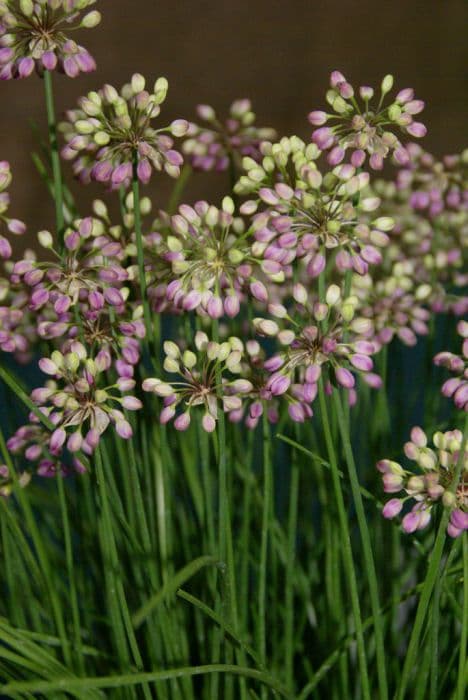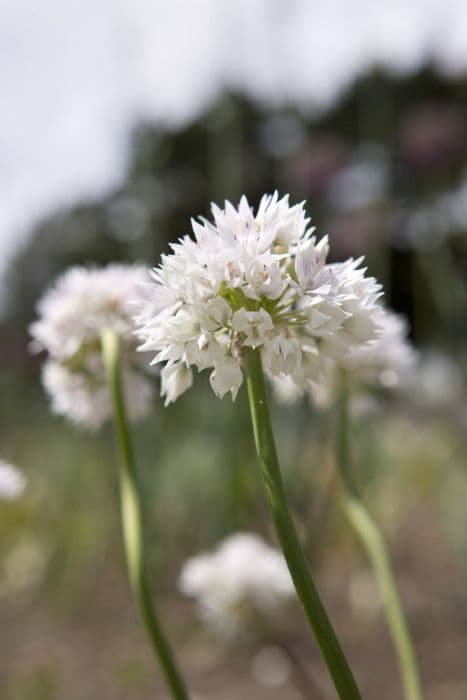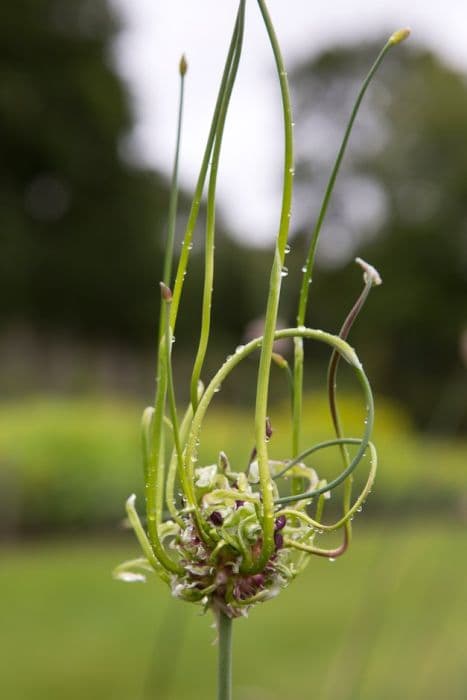Japanese onion Allium thunbergii 'Ozawa'

ABOUT
Allium thunbergii 'Ozawa', commonly known as the Japanese onion, is noted for its late season blooms and compact clumping habit. This ornamental onion displays rounded clusters of star-shaped flowers. These small but numerous flowers create a showy, globe-shaped inflorescence. The blossoms are typically a vibrant pink to purple hue, adding a burst of color to the autumn garden when many other plants are fading. The foliage of the Japanese onion consists of narrow, glossy green leaves that form a dense and grass-like tuft at the base of the plant. The leaves grow in a linear fashion, and they often twist or curve, providing texture and visual interest even when the plant is not in bloom. The leaves usually remain attractive throughout the growing season, serving as a tidy backdrop for the decorative blooms. The flowering stems, which rise above the foliage, are slender and sturdy, allowing the flower heads to sway gracefully in the breeze. The overall appearance of the plant is one of delicate elegance, with its fine-textured leaves and airy flower heads creating a striking contrast to more substantial garden foliage. The Japanese onion is typically grown in ornamental gardens for its decorative flowers and attractive foliage. It is often planted in clusters or used as a border plant, where its vivid blooms can be appreciated up close. Its late flowering period makes it especially valuable for adding interest to the garden at a time when many other flowering plants may be past their prime.
About this plant
 Names
NamesFamily
Amaryllidaceae
Synonyms
Japanese Onion, Thunberg's Chive, Ozawa's Allium, Ornamental Onion
Common names
Allium thunbergii 'Ozawa'.
 Toxicity
ToxicityTo humans
Japanese onion, or Allium thunbergii 'Ozawa', is generally considered non-toxic to humans. While eating modest amounts of this plant is unlikely to cause harm, consuming it in large quantities may lead to digestive discomfort, as with any allium species.
To pets
Japanese onion, or Allium thunbergii 'Ozawa', is toxic to pets, especially cats and dogs. Ingesting this plant can result in symptoms such as vomiting, diarrhea, abdominal pain, and lethargy. In severe cases, it can cause oxidative damage to red blood cells, leading to hemolytic anemia. If a pet consumes Japanese onion, it is important to seek veterinary care immediately.
 Characteristics
CharacteristicsLife cycle
Perennials
Foliage type
Deciduous
Color of leaves
Green
Flower color
Pink
Height
1-2 feet (30-60 cm)
Spread
0-1 foot (0-30 cm)
Plant type
Bulb
Hardiness zones
4-8
Native area
Japan
Benefits
 General Benefits
General Benefits- Ornamental Appeal: Allium thunbergii 'Ozawa', commonly known as Japanese onion, adds aesthetic value to gardens with its rounded clusters of purple-pink flowers and slender, grass-like foliage.
- Long Blooming: It has a long blooming season from late summer into autumn, providing color when many other plants have finished flowering.
- Attracts Pollinators: Japanese onion is attractive to pollinators such as bees and butterflies, which benefit the overall health and productivity of the garden ecosystem.
- Easy to Grow: This plant is known for being easy to grow and maintain, tolerating a range of soil types and conditions, making it suitable for gardeners of all skill levels.
- Drought Tolerance: Once established, it exhibits good drought tolerance, reducing the need for frequent watering.
- Deer and Rodent Resistant: The plant is rarely damaged by deer or rodents, which can be beneficial in areas where these animals are a common issue for gardeners.
- Culinary Use: While not a medical benefit, the leaves of the Japanese onion are edible and can be used in a similar way to chives in cooking.
- Low Maintenance: It requires minimal care once established, with no need for deadheading, and is generally free from major pests and diseases.
- Multiplication: The plant can naturally multiply over time, with clusters expanding each year, providing more plants for division and sharing with fellow gardeners.
- Year-Round Interest: Japanese onion provides structure to the garden, with the dried flower heads remaining attractive even after the blooming period, offering visual interest into the winter months.
 Medical Properties
Medical PropertiesThis plant is not used for medical purposes.
 Air-purifying Qualities
Air-purifying QualitiesThis plant is not specifically known for air purifying qualities.
 Other Uses
Other Uses- Ornamental fabric dye: The blossoms of the Japanese onion can be used to create a light green hue when used as a natural dye for fabrics.
- Floral arrangements: The long stems and vibrant purple flowers of Japanese onion make it a striking addition to floral displays and bouquets, often bringing a unique texture and form to the composition.
- Garden border color accent: Japanese onion's late-season purple blooms provide a striking color contrast when used as a border plant alongside other autumnal perennials in a garden setting.
- Photography subject: Its distinct flower heads and rich color make Japanese onion an interesting subject for botanical photographers.
- Educational tool: In schools or educational gardens, the plant can be used to teach about the lifecycle of perennial plants and the onion family in particular.
- Culinary garnish: Although not commonly used for this purpose, the flowers of Japanese onion can be used as a decorative garnish for food presentation.
- Container gardening: Due to its compact size and ornamental appeal, Japanese onion is well-suited for inclusion in container gardens, where it can add height and color.
- Wildlife garden inclusion: Planting Japanese onion may attract pollinators such as bees and butterflies, enhancing the biodiversity of a wildlife-friendly garden.
- Erosion control: When planted in groups, the root system of Japanese onion can help stabilize soil and control erosion on slopes or in areas prone to heavy rain.
- Cultural festivals: In Japan, the Japanese onion may be included in floral displays during certain seasonal festivals that celebrate native plants and flowers.
Interesting Facts
 Feng Shui
Feng ShuiThe Japanese onion is not used in Feng Shui practice.
 Zodiac Sign Compitability
Zodiac Sign CompitabilityThe Japanese onion is not used in astrology practice.
 Plant Symbolism
Plant Symbolism- Perseverance: The Allium thunbergii 'Ozawa', commonly known as 'Japanese Onion', is known for its late bloom in the season, which symbolizes perseverance and the ability to thrive even as colder temperatures approach.
- Unity: With its tight clusters of flowers, the Japanese Onion symbolizes unity and togetherness, reflecting how individuals can come together to create something beautiful.
- Humility: Despite its bright, noticeable flowers, Allium thunbergii 'Ozawa' maintains a modest height, which can be seen as a sign of humility and understated elegance.
- Good Fortune: In some cultures, the spherical shape of the blooms is associated with prosperity and good luck, as the shape is reminiscent of coins and wealth.
 Water
WaterJapanese onion, Allium thunbergii 'Ozawa', prefers consistently moist but well-draining soil. During the active growing season in spring and summer, water these plants deeply once a week, ensuring you're applying enough water to saturate the roots without causing standing water. This will often mean providing about 1-2 gallons of water per plant, depending on your soil type and climate. Reduce watering frequency to every other week in the fall, tapering off in preparation for their dormant winter period. Always check the top inch of soil for dryness before watering as overwatering can lead to bulb and root rot.
 Light
LightJapanese onion thrives in full sun conditions where it can receive at least 6 hours of direct sunlight each day. The best spot for this plant is in a location where it's exposed to bright, unfiltered light throughout the day. If planted in partial shade, its blooming may be reduced, so prioritizing sun exposure will promote stronger blooms.
 Temperature
TemperatureThe Japanese onion performs best in a temperate range, ideally between 55°F and 75°F. It can survive light frosts and temperatures as low as 20°F, making it suitable for many garden zones. However, prolonged exposure to temperatures below freezing or above 85°F can stress the plant, potentially leading to reduced vigor and fewer blooms.
 Pruning
PruningJapanese onion benefits from pruning primarily to remove spent flower stems and to tidy up the plant after blooming in late fall. Prune the flower stalks down to the base of the plant after the blooms have faded to encourage energy reserves for the next season's growth. Additionally, remove any yellowing or dead foliage to maintain plant health and appearance.
 Cleaning
CleaningAs needed
 Soil
SoilJapanese onion, or Allium thunbergii 'Ozawa', thrives in well-draining, loamy soil with a pH range of 5.5 to 7.0. A mix of two parts garden soil, one part compost, and one part coarse sand or perlite is ideal. Ensure the soil is fertile and enriched with organic matter to support healthy growth.
 Repotting
RepottingJapanese onion, also known as Allium thunbergii 'Ozawa', typically doesn't require frequent repotting and can be repotted every 2-3 years or when it becomes root-bound. Ensure to refresh the soil during repotting to provide fresh nutrients.
 Humidity & Misting
Humidity & MistingJapanese onion, referred to as Allium thunbergii 'Ozawa', is tolerant of a wide range of humidity levels and does not require specific humidity conditions for growth. Normal outdoor humidity is generally sufficient for this hardy plant.
 Suitable locations
Suitable locationsIndoor
Place in sunny spot with well-draining soil.
Outdoor
Plant in full sun to partial shade and well-draining soil.
Hardiness zone
4-9 USDA
 Life cycle
Life cycleAllium thunbergii 'Ozawa', commonly known as Japanese onion, begins its life cycle with seed germination, which typically occurs in spring. The germinated seeds develop into young plants with a basal rosette of leaves. As the plant matures, bulbs form underground, followed by the emergence of a long, slender stem, known as a scape, during late summer or early autumn. Atop the scape, clusters of purple-pink flowers bloom, attracting pollinators such as bees and butterflies. After pollination, the flowers develop into seed capsules, and once the seeds fully mature, they are dispersed, completing the reproductive cycle. The plant itself dies back to the bulb during winter, where it lies dormant until the next growing season begins.
 Propogation
PropogationPropogation time
Late summer-early fall
Allium thunbergii 'Ozawa', commonly known as Japanese onion, is most effectively propagated through division, ideally done in autumn or early spring before growth begins. To propagate by division, carefully dig up the clump of the plant, taking care not to damage the bulbs. Separate the bulbs gently by hand, ensuring that each division has at least one set of leaves or a portion of the root system attached. Replant the divisions promptly at a depth of about 2 to 3 inches (5 to 7.6 centimeters) in well-draining soil, spacing them approximately 8 to 12 inches (20 to 30 centimeters) apart to allow for sufficient room for growth. Water the newly planted divisions thoroughly to help establish them in their new location.








